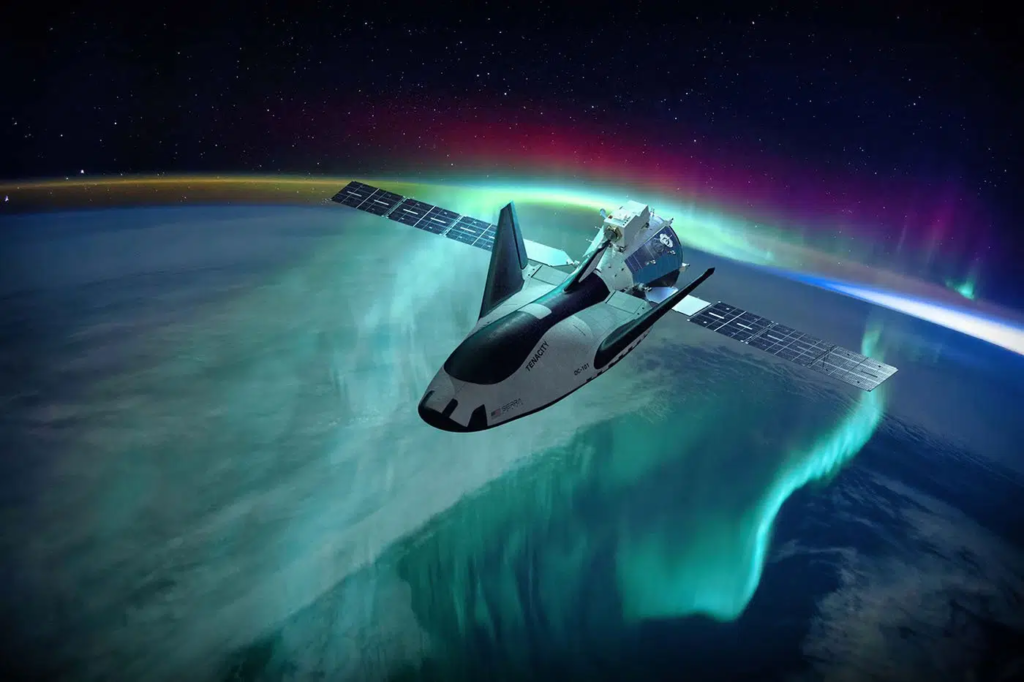The Dream Chaser spaceplane is a multi-mission vehicle capable of supporting a variety of LEO needs. It can be customized for both domestic and international customers via vehicle configuration, launch site, destination, landing site, duration, and a host of other variables. We have entered into agreements with multiple international space agencies. Together we are developing technologies, applications, and missions for Dream Chaser-based space systems.

Dream Chaser is an American reusable lifting-body spaceplane being developed by Sierra Nevada Corporation (SNC) Space Systems. Originally intended as a crewed vehicle, the Dream Chaser Space System is set to be produced after the cargo variant, Dream Chaser Cargo System, is operational. The crewed variant is planned to carry up to seven people and cargo to and from low Earth orbit.
The Dream Chaser model with its Atlas V launch vehicle is undergoing final preparations at the Aerospace Composite Model Development Section’s workshop for buffet tests at the Transonic Dynamics Tunnel at NASA Langley. The scale model is being tested as part of NASA’s Commercial Crew Development program to regain the American capability to launch astronauts safely to the International Space Station. The lifting body reusable spacecraft would carry as many as seven astronauts to the space station. Sierra Nevada Space Systems is developing the craft under a Space Act Agreement with NASA.
With the help of hundreds of pressure transducers, engineers from Sierra Nevada Corporation, the United Launch Alliance and NASA Langley will look at the pressure fluctuations the model and launch vehicle stack experience during the critical ascent to orbit, especially at transonic speeds. Shock-waves form on launch vehicles as they approach the speed of sound and may result in regions of highly unsteady flow.
Within these regions of the Dream Chaser and launch vehicle, the resulting buffet forces and high frequency acoustic noise must be clearly understood as part of the vehicle design process. Transonic wind-tunnel testing of large, highly instrumented scale models is the only method of determining the buffet environments of launch vehicles with complex shapes.
Image Credit: NASA EDGE/Ron Beard
The cargo Dream Chaser is designed to resupply the International Space Station with both pressurized and unpressurized cargo. It is intended to launch vertically on the Vulcan Centaur rocket and autonomously land horizontally on conventional runways. A proposed version operated by ESA would launch on an Arianespace vehicle.
Dream Chaser spaceplane, also known as America’s Spaceplane, is a reusable, multi-mission space utility vehicle being developed by Sierra Nevada Corporation (SNC) to transport crew and cargo to low-Earth orbit (LEO) destinations.
It will become the only non-capsule, commercial spacecraft in the world and also the only commercial, lifting-body vehicle with the capability to land on a runway.
The First-Ever Winged Commercial Spaceplane
Capable of gentle 1.5G runway landings, ideal for precious cargo, especially human passengers
Accommodates more than 12,000 pounds of supplies and equipment
NASA resupply missions for the International Space Station begin in 2023
Configuration intended for up to seven crewmembers, plus critical supplies
Compatible with a wide array of current and future launch vehicles
Crewed
Dream Chaser was originally designed as a crewed spaceplane, in part under NASA’s Commercial Crew Program, capable of carrying up to seven astronauts to and from the space station and other low Earth orbit (LEO) destinations. Dream Chaser is 30 feet, or 9 meters long—roughly ¼ the total length of the space shuttle orbiters—and can carry up to seven crew members.
The crewed version of Dream Chaser is approximately 85% common to the cargo system, limiting primary changes to windows, environmental control and life support systems. In addition, an integral main propulsion system is available for abort capability and major orbital maneuvers.
Uncrewed
Under NASA’s Commercial Resupply Services 2 (CRS-2) contract, Dream Chaser will provide a minimum of seven cargo service missions to and from the space station.
With the help of our Shooting Star™ service module, Dream Chaser can deliver up to 5,500 kg of pressurized and unpressurized cargo to the space station, including food, water, supplies, and science experiments and returns to Earth. Dream Chaser can return critical cargo at less than 1.5 g’s using a gentle runway landing.
Designed for high reusability, this vehicle reduces overall cost, providing quick turnarounds between missions. The ability to liftoff on top of multiple launch vehicles and land at a wide variety of runways makes Dream Chaser a flexible option for reliable transportation.
After leaving the space station, the Dream Chaser Cargo System also offers disposal services via the Shooting Star transport vehicle. Once separated from Dream Chaser, Shooting Star burns up safely in Earth’s atmosphere.
The spacecraft will provide cargo delivery and disposal services to and from the International Space Station (ISS) under Nasa’s Commercial Resupply Services-2 contract. It will perform at least six missions to the ISS with first flight expected in spring 2021.
Dream Chaser is being designed, manufactured and assembled in Colorado, US, while refurbishment between flights will be performed at the Kennedy Space Center.
The company is also considering additional flight opportunities to LEO for domestic and international customers. The vehicle can be customized in terms of vehicle configuration, launch site, landing site, duration and other factors to meet the varied customer requirements.
SNC also signed agreements with several international space agencies and is developing technologies, applications and missions for space systems based on Dream Chaser.
Credit : Nasa
Credit : https://www.sncorp.com/
